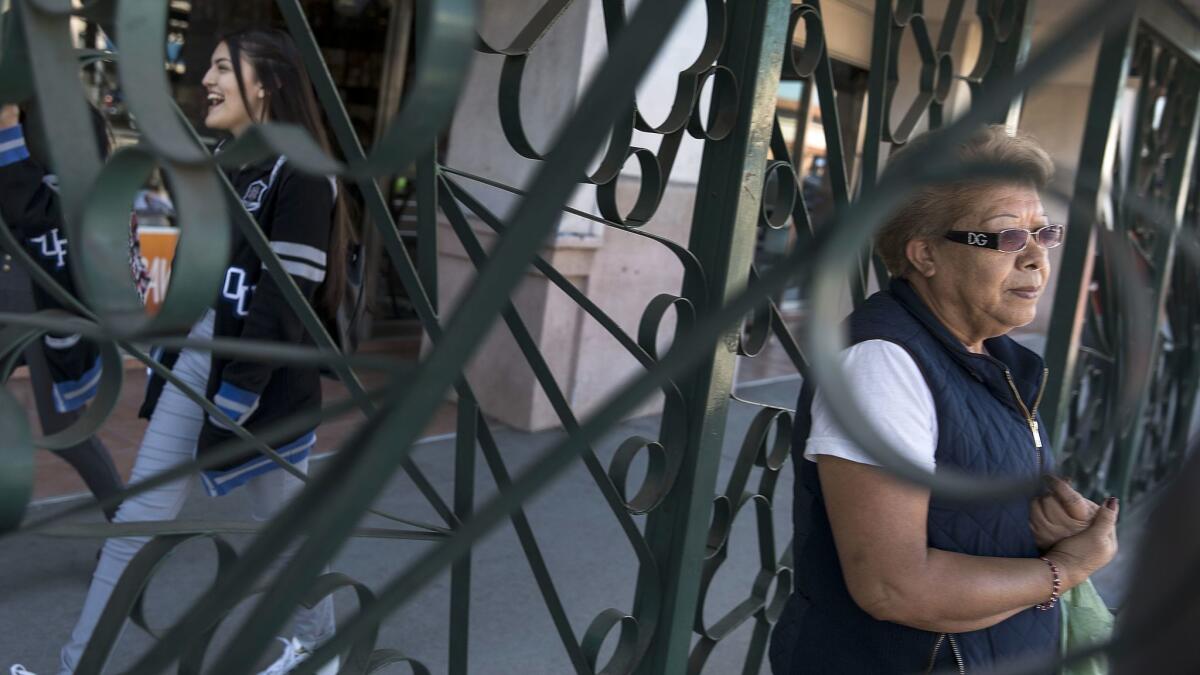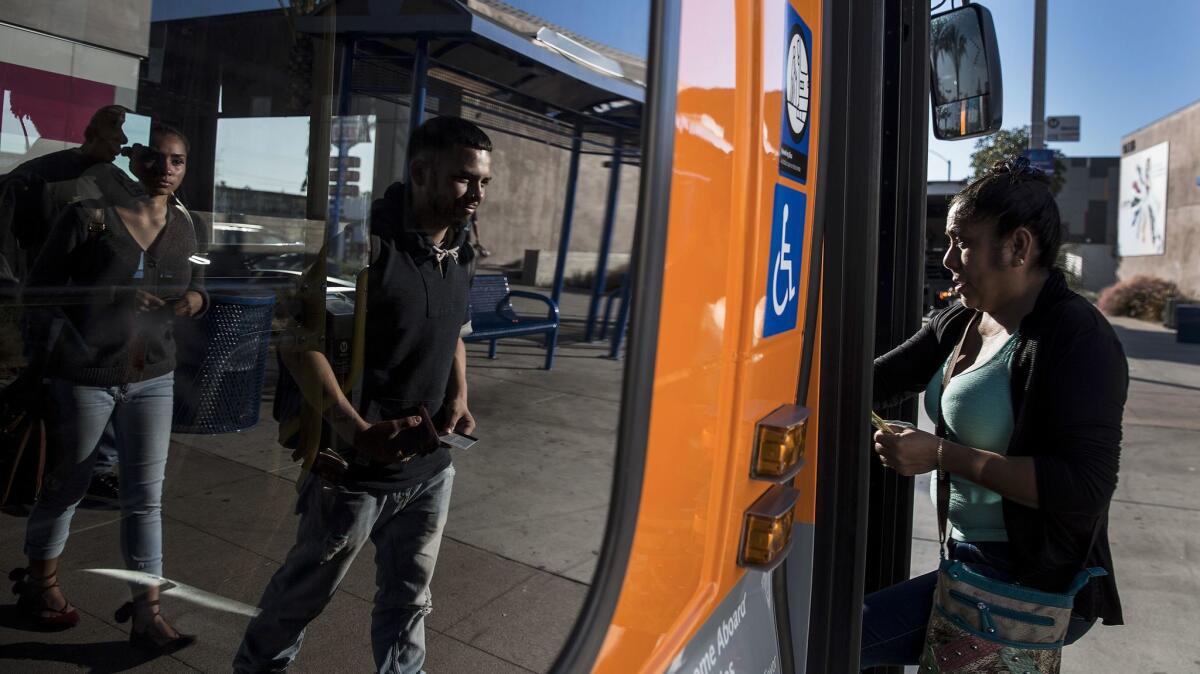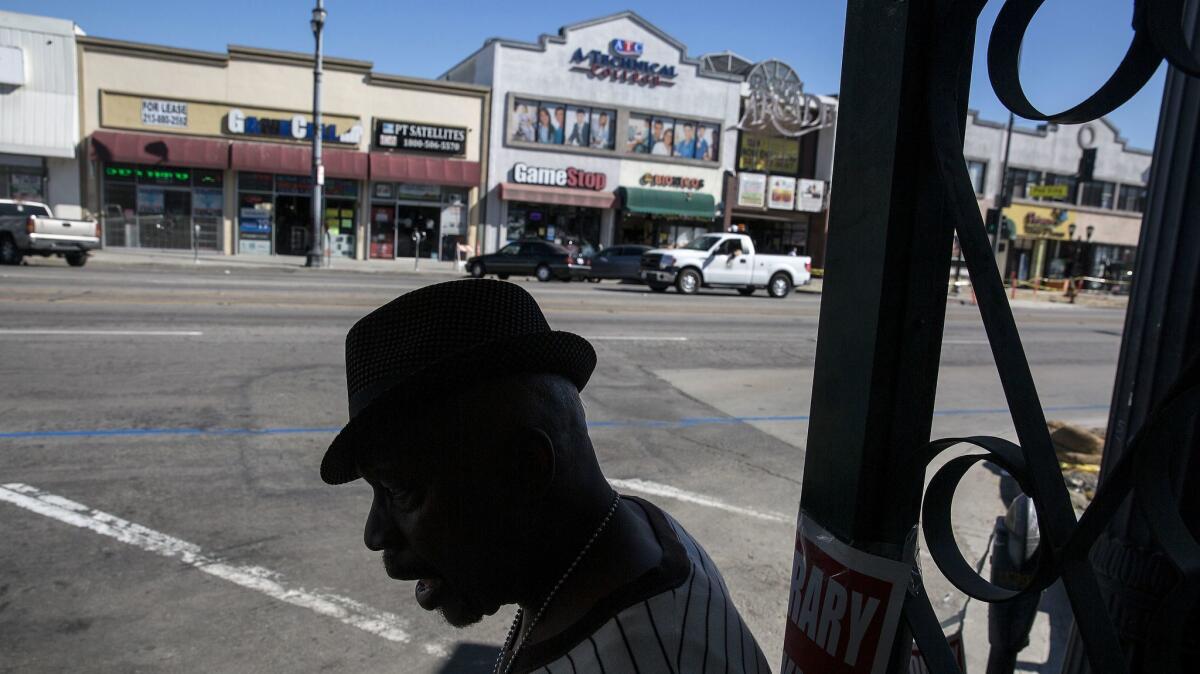Why these southeast L.A. cities are banding together to fight Measure M, the transportation tax

Each day, Emilia Mata boards three buses from Huntington Park to her factory job in Los Angeles.
The trip can take up to 2 ½ hours one way and often leaves her right leg sore and swollen.
For the record:
7:42 a.m. April 23, 2024A previous version of this article said that South Gate recently switched in favor of the measure. South Gate, as a member of the Gateway Cities Council of Governments, now supports the measure. The South Gate City Council, however, opposes the proposal.
She is among the many bus riders who could benefit if voters pass Measure M on Tuesday. The sales tax increase is tied to transportation and would fund more than a dozen major transit projects, including a rail line that would connect downtown Los Angeles to more than a dozen southeast cities, such as Huntington Park, South Gate, Paramount, Bellflower and Artesia.
The only problem, critics say, is that the West Santa Ana Branch Line, as it’s called, probably won’t be completed until 2041.
That’s a long time for Mata, 64, a seamstress who will be 89 by then.
“God knows, I’ll probably be dead,” she said, laughing, as she waited for the final bus home on a recent afternoon.

Officials expect strong voter support for Measure M in central Los Angeles and on the Westside. But in the southeast portion of the county, many cities have banded together to oppose the proposal, arguing that their residents would not see their fair share of transit projects.
That dissent, experts said, could keep the plan from winning the necessary two-thirds majority.
The ballot measure would raise an estimated $860 million a year by creating a new half-cent tax with no end date. The rate would increase to 1% in 2039 when another half-cent tax expires.
The tax would provide a permanent source of revenue for the Metropolitan Transportation Authority, giving the agency more leeway to draft one of the most ambitious transit plans in recent U.S. history. The proposals include untangling many highway bottlenecks, building a rail tunnel through the Sepulveda Pass and helping with overall transit operations and maintenance. It would also help cities with local needs, such as pothole repairs and sidewalk improvements.
In the southeast area, where many of the 2.1 million residents are blue-collar workers and the car-less rely heavily on buses, a train would be a game-changer. Metro estimates that up to 75,000 people would ride the West Santa Ana Branch Line, which would run from Union Station to Artesia. That compares only to the Blue Line, Metro’s busiest light rail, which has an estimated 81,000 weekday boardings.

“Our whole way of life would be different,” said Huntington Park City Councilwoman Karina Macias. “People would take it to work, to school, and it would help us promote our city and all our businesses.”
The line had received $240 million in seed funding from Measure R, the half-cent sales tax voters approved in 2008. Back then, officials set a tentative opening date of 2027.
Measure M offers two completion dates: the first half of the line, to the south, would open in 2028, and the full ribbon-cutting would occur in 2041.
Many leaders in cities such as Maywood, Paramount and Bellflower, who have been pushing for a train for more than a decade, felt snubbed by the switch.
“We’re not saying our project should go in front of anyone else’s, but there should be a fair and equitable distribution of projects in different parts of the county,” said Nick DeLuca, spokesman for the Gateway Cities Council of Governments, a group of 27 cities that mostly opposes the plan.
With contributions from a number of cities, the council launched an educational campaign to inform residents about the potential downsides to Measure M.

Some worry that massive projects, such as the $8-billion Sepulveda Pass tunnel, could delay the West Santa Ana Branch Line beyond 2041.
“We have some legitimate concerns about what will happen” when work starts on the tunnel, said Karen Heit, transportation deputy for the Gateway Cities Council. “They could start digging and find a community of trolls living under there, and then things will get pushed out more.”
Sensing the discord, Metro officials and Los Angeles Mayor Eric Garcetti began meeting with leaders in southeast cities to address their concerns.
According to Metro officials, Measure R did not specify rail construction. It provided funding for transportation research, along with an opening date, which was subject to change depending on what research produced, said Metro spokeswoman Pauletta Tonilas.
Now, with Measure M, a southeast light rail line will be built at a cost of $4 billion, she said. The project’s finish date was determined after ranking it against dozens of other county projects — taking into account their cost and how well they provide safety, mobility and sustainability, among other things.
“We know everyone would like their projects to be done in the first 15 years,” Tonilas said. “But we did the best we could with all the tools we had to deliver equity for decades to come.”
The outreach paid off, to a certain degree. Council representatives for a few cities — such as Compton, South Gate and Huntington Park — switched in favor of the measure. The South Gate City Council, however, continues to oppose Measure M.
Macias, the Huntington Park council member, was among those who changed their minds. She said Metro officials seemed to listen and understand the area’s concerns. They spoke of possible public and private partnerships to potentially move up the rail line’s opening date by a few years. Last month, the Metro board approved a contract to do initial environmental work.
“It’s still not a perfect plan by any means, but we’re providing an olive branch,” Macias said. “I will be knocking on their door if projects don’t move forward as promised.”
Looking ahead, Macias said the southeast cities stand to lose more if the measure passes and they have a sour relationship with Metro.
Gene Daniels, a 20-year member of Paramount’s City Council, doesn’t buy that logic.
“They can tell you anything they want to tell you,” he said. “But it’s not going change what’s already in Measure M. When you’re a politician, you’re only as good as the next election.”
Daniels is concerned that his constituents will be stuck with an endless tax that will hardly, if ever, benefit them.
“People believe they’ll vote Tuesday and that Wednesday they’ll be fixing streets, fixing highways and building that train, but they won’t,” he said. “That money will go to the Westside.”
At bus stops across the southeast, riders’ opinions varied. Many would not be voting because they are not citizens, but if the measure passes, their sales tax will increase just the same.
Mata, the seamstress, said that even though she is probably too old to benefit from the light rail, she would gladly pay a higher tax rate for the sake of her grandchildren.
“We can’t just think of ourselves,” she said. “We need to make a path for those who will come after us.”
Jessica Zepeda, 22, plans to vote for the first time Tuesday. The South L.A. resident takes two buses to work at a beauty shop in South Gate. The trip lasts 45 minutes.
Sitting outside the Azalea Shopping Center on a recent evening, Zepeda said she hadn’t given much thought to how she’d vote. She knew about Donald Trump and Hillary Clinton, but the local measures? She had no idea where to begin.
“Honestly,” she said. “I just want my husband to buy me a car.”
esmeralda.bermudez@latimes.com
ALSO
How Riverside County became California’s death penalty leader
Arrests of protesters at Alfred Olango shooting site in El Cajon can continue, judge rules
More to Read
Start your day right
Sign up for Essential California for news, features and recommendations from the L.A. Times and beyond in your inbox six days a week.
You may occasionally receive promotional content from the Los Angeles Times.







